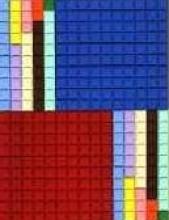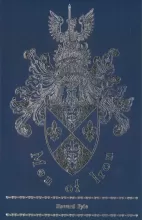No name
Math-U-See
Math-U-See is a fairly new Math program, designed especially for homeschoolers, which runs from Kindergarten all the way through high school. The author is a former high school Math teacher who has attempted to balance a solid conceptual understanding of math with enough practice to let it "sink in." The program consists of a student text (workbook format), a teacher's manual, and optional practice sheets, special Math-U-See blocks and a teacher training DVD. I am very impressed with this program. The author does a fine job of allowing the students to become well aquainted with using numbers. I found math concepts very easy to explain to my daughter with the use of the very clever manipulatives (which might be thought of as a cross between "Base-ten Blocks" and Cuisinaire Rods). I was particularly impressed with how clearly place value is taught and how thoughtfully the child is prepared for future lessons (e.g. early on in addition, the child starts doing simple "solve for the unknown" problems in preparation for subtraction). Other skills learned include telling time, measurement and a heavy emphasis on skip counting (in preparation for future multiplication and factoring). My only complaint is that some of the material is contained only in the teacher's manual (I can imagine that this might have been done intentionally to force the parent to follow along in the teacher's manual rather than letting the child work entirely on their own. The author demonstrates how each concept works on the DVD so that the parent may more confidently teach the concept to the child.
Over the years we haven't always used Math-U-See as our primary Math text, but we have always found the DVDs and blocks useful no matter what we were using.
Meat & Potatoes Catholicism
Ordained in 2003, this is Fr. Classen's second book published by Our Sunday Visitor.
Meet the Masters
Years ago, a friend who teaches university-level art classes, told me that the best way for me to teach my children art was to combine how-to instruction with art appreciation. She suggested learning about the life of a particular artist by reading biographies and then learn how to imitate his or her technique. This made perfect sense to me, but I did not feel knowledgeable enough in the subject matter to put together my own curriculum and I did not know of any such art program that could be used in the home.
Enter Meet the Masters. This program integrates how-to instruction with art appreciation.
To review Meet the Masters, I invited two other families to join me and my children in using the program, forming a co-op of sorts. My desire was to get a feel of the program myself, as well as see how other families responded to the instruction. I am happy to report that our little art co-op was very successful.
In the first lesson the children learned about the life of Vincent Van Gogh, through the CD-ROM that comes with the program and the Internet. All of the children gathered around me and the computer, as I read from the script that comes with the program. It is good that Meet the Masters provides scripted instruction, as my personal knowledge of famous artists is admittedly limited. I learned about the life of Van Gogh alongside my children.
After reviewing Van Gogh's biography, we moved to the dining room table where we learned about his art technique and the children could mimic it. The program provides careful instructions on how to help the children with the lesson. It also provides a supply list and set-up instructions, so I was well prepared before our friends arrived.
I enhanced the program a little by searching out more of Van Gogh's artwork on the Internet and even saved one of his paintings to use as "wallpaper" on the children's computer (just left-click on the picture). That way every time the children booted up the computer, they were treated to a beautiful piece of art. I also picked up a children's biography at the library.
We met with our friends every other week until the program was finished. During that time we learned about Mary Cassatt, Piet Mondrian, Pablo Picasso, Claude Monet, and Winslow Homer. My children and the children of my friends (ages seven to twelve) all enjoyed the program and were even heard speaking about things such as texture, complementary colors, contrast, and the such throughout the weeks. On more than one occasion, my children recognized, and were excited to see, prints of the artists that we studied while visiting friends' homes or the doctor's office.
Though I do like this program very much, I am disappointed at the high price tag. It is expensive and parents must weigh the benefits with the cost carefully. However, the publisher does offer a generous discount if customers order more than one grade level at one time. A computer with a CD-ROM and Internet access is necessary to use Meet the Masters.
Note: This review is a bit out-dated. You can look at their current offerings here: http://meetthemasters.com/
Memoria Press' Henle Latin Guides
Second volume published in 2003.
Memorize the Faith! (and Most Anything Else): Using the Methods of the Great Catholic medieval Memory Masters
Men of Iron
This is a stirring tale in the tradition of the Knights of the Round Table and Ivanhoe. It takes place in the early 15th century. Myles Falworth is a young boy brought up in a poor but noble household, late in the reign of Henry IV of England. His father, a supporter of Richard II, has been unfairly accused of treason and outlawed. As a youth, Myles is sent as squire to the household of an old family friend, where his unpolished manners, fierce strength of will and impulsive actions win him both loyal friends and fervent enemies.
Over the course of time he finds that he is being prepared to clear his father's name. The first part of the book tells about his training in the chivalric arts of war; the second part tells of his young adulthood. In the final encounter with his family's bitter enemy, the stakes are high; not only his father's good name and the family fortune, but also his future happiness with his chosen bride, and his very life.
Men of Iron is written and illustrated by Howard Pyle, who lived around the turn of the century and was also the author of many other classics such as Otto of the Silver Hand, The Merry Adventures of Robin Hood, several Arthurian romances, and Garden behind the Moon. The language is old-fashioned and complex by today's standards, and some passages of historical detail might slow this book down as a read-aloud, but the story is involving and inspiring. I think it could be read aloud to a child as young as nine, and a 12 to 16 year old would enjoy reading it alone.
Mental Math: Fifth Grade
Problems at this level include a review of 4th grade math and practice in the topics usually introduced at the 5th grade level. In the 10 questions for each day, concepts of numbers, computation, application, mixed practice, decimals, fractions and percents are covered. Sample questions chosen at random include the following: What number when multiplied by six and divided by three becomes 12? Write seven and four tenths as a mixed number with a decimal. How much time has elapsed from 4:31 a.m. to 7:01 a.m.? 72 people were on the train. 1/8 of them got off at the first stop. How many people were left on the train? What is the volume of a box that is 2 cm by 2 cm by 2 cm?
Mental Math: First Grade
Problems at this level center around practice in the topics usually introduced at the 1st grade level. In the 5 questions for each day, concepts of numbers, computation, application, and mixed problems are covered. Sample questions chosen at random include the following: Write the number 203. What comes next: 50, 100, 150, ___ ? What month comes after March? A square has ___ sides. Jenny is six months old. Nicki is ten months old. Which one is almost one year old?
Mental Math: Fourth Grade
Problems at this level include a review of 3rd grade math and practice in the topics usually introduced at the 4th grade level. In the 10 questions for each day, concepts of numbers, computation, application, and mixed practice are covered. Sample questions chosen at random include the following: Increase the tens place by one in the number 23,460. What is the area of a square that is 4 feet on a side? What number when multiplied by two becomes 22? AZ, AY, AX, ____. What comes next? If I put five red marbles and one green marble in a bag, what are my chances of picking a red marble? Write it as a ratio.









